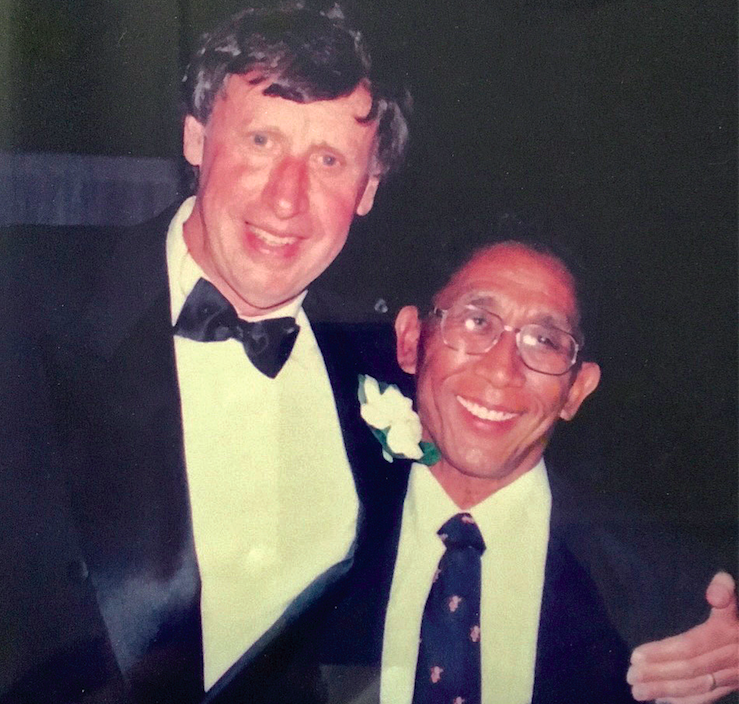Our head Sherpa, or sirdar, on my first trek in the Himalaya was a polite man named Pasang Kami. He was short, wore glasses, and spoke only when he needed to. He had no schooling, but had taught himself to read, speak, and write in Nepali and English. He was ambitious and a hard worker. Everyone called him P. K.
I liked him instantly. Backpacking with two Bay Area friends through rhododendron forests, giant bamboo ranges, and other fascinating terrain as we made our way through narrow trails, high passes, and deep valleys near Annapurna, the tenth-highest peak in the world, I was thankful many times for P.K.’s gentle spirit, tips and advice, and watchful eye.
P.K. and I (pictured above) became good friends, sharing many more treks and adventures. He was more than a good friend – he was an inspiration. Here, I came to realize, was a Buddhist’s compassion on display.
P.K. and his wife eventually had six children—five daughters first and later a son. I was always welcomed as a member of his extended family.
One day P.K. told me, “Dick, if my daughters don’t get an education, and they don’t get married, they’ll spend their lives carrying loads up and down the mountains.” He couldn’t afford to send them more than fifty miles away to boarding school in Kathmandu. But I could, so I immediately made this promise: “P. K., from today on, your daughters are my daughters. You get them into school. We’ll help educate them.”
And that’s how things turned out. All of P.K.’s children attended schools in Kathmandu, and three studied further in North America. Proof that when children anywhere in the world are given the right resources, under the right conditions, many will thrive, and some will accomplish wonders.
When climbing buddies heard of my promise to educate P.K.’s children, they were eager to do the same for the children of their Sherpa guides. We agreed that this gesture was the least we could do, and should do, for the men who guided us through extraordinarily challenging physical conditions.
Touched deeply by these bonds and friendships, we organized the American Himalayan Foundation to expanded fund-raising and add projects. Fast-forward to today: the foundation’s work now helps more than 300,000 people a year.
P.K.’s oldest daughter, Nawang (with me in 2009 photo, below), is one of them. After completing college studies in Kathmandu, she enrolled in an unusual program designed for dental technicians in extremely cold climates. It was in Saskatchewan, 250 miles north of the Montana border. At times, Nawang felt isolated there, a cultural misfit. Yet she persevered. For nearly thirty years now, she has provided hundreds of people in her Khumbu community with dental care at the clinic in her village, Namche Bazaar.
The devastating 2015 earthquakes in eastern Nepal destroyed much of her clinic, but with help from the community and our foundation, Nawang reopened early this year. We had another reason to celebrate by summer. One of her sons (and P.K.’s grandsons), graduating with straight-As and an accounting diploma from the University of San Francisco, was hired by Deloitte & Touche at a starting salary exceeding $60,000.



Leave a Reply